
* The biplane was clearly an obsolete concept by the beginning of the Second World War; and so it is somewhat surprising that one biplane, the British Fairey "Swordfish" torpedo bomber, proved a highly effective weapon. The Swordfish remained in first line-service through the entire war in Europe. Fairey followed the Swordfish with two more torpedo-bombers, the "Albacore" and the "Barracuda". Neither achieved the prominence of the Swordfish, and in fact the Swordfish outlived the Albacore in service. This document provides a history and description of the Swordfish, Albacore, and Barracuda. A list of illustration credits is included at the end.
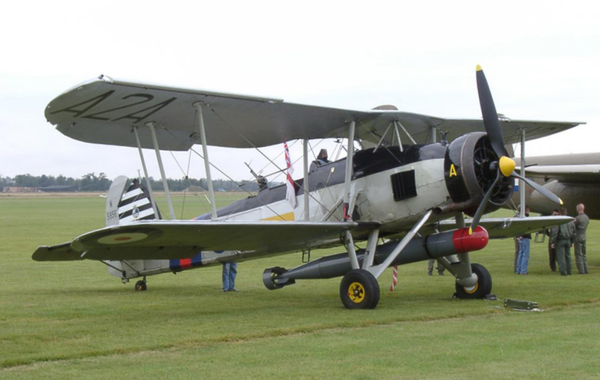
* The Swordfish started out in 1933 as a private venture by Fairey Aviation Company Limited, in the form of the three-seat "Torpedo Spotter Reconnaissance I (TSR.I)" aircraft, developed by a team under Marcel Lobelle, a Belgian who was Fairey's chief designer. The TSR.I was a biplane of frame-and-fabric construction, powered by a Bristol Pegasus IIM nine-cylinder air-cooled radial engine with 475 kW (635 HP). The TSR.I first flew in March 1933, and was put through a successful series of tests. Unfortunately, in September of that year, during spin tests the prototype failed to recover from a flat spin that took it into the ground. The pilot was able to bail out -- with difficulty -- but the aircraft was destroyed.
The TSR.I had seemed promising enough to justify further work, and when the British Air Ministry issued Specification "S.15/33", requesting a carrier-based torpedo bomber and scout aircraft, Fairey built a second prototype, the "TSR.II", which first flew on 17 April 1934. The new aircraft included an uprated Pegasus IIIM3 engine, providing 515 kW (690 HP); aerodynamic changes to improve spin handling; a longer fuselage; plus slightly swept back wings to compensate for the longer fuselage and shift in center of gravity.
Land trials went well, and in November 1934 the TSR.II was fitted with floats for sea trials, which culminated in catapult launch and recovery by the battle cruiser HMS REPULSE. The floats were then traded back to landing wheels for final evaluation. The Air Ministry was suitably impressed and placed an order for three pre-production machines.
The first of the three pre-production aircraft, with the type now named the "Swordfish", was flown on 31 December 1935. The last of the three was fitted with floats for service trials on water. The three prototypes were followed by a production order for 68 Swordfish "Mark I" aircraft.
By 1938, the Swordfish had replaced all other torpedo bombers in the service Royal Navy's Fleet Air Arm (FAA). By the outbreak of World War II in September 1939, thirteen squadrons had been equipped with the Swordfish, with twelve of the squadrons at sea on the carriers HMS ARK ROYAL, COURAGEOUS, EAGLE, FURIOUS, and GLORIOUS. By the end of the war, there would be thirteen more operational squadrons flying the Swordfish. The last operational squadron was established in June 1943, and was staffed by Dutch naval personnel fighting in exile. Twenty training squadrons were built up as well.
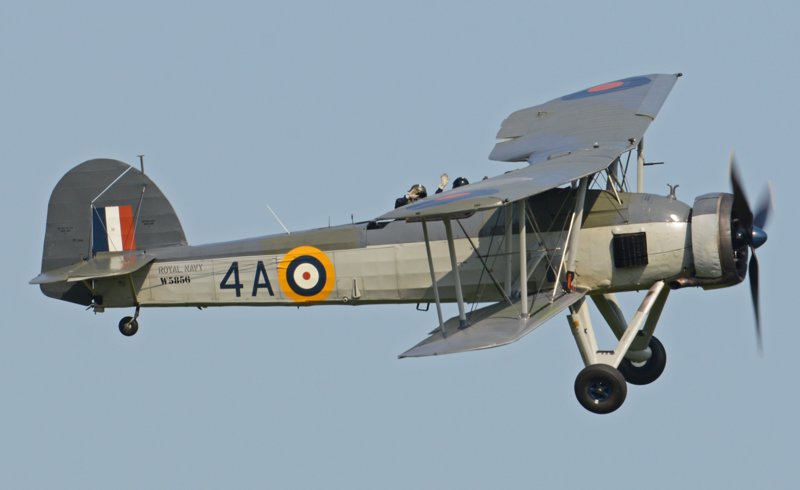
* The Swordfish was, as noted, a frame-and-fabric biplane with the frame mostly made of steel tubing. The Pegasus IIIM3 radial engine drove a three-bladed fixed-pitch metal propeller, though the TSR.2 had been fitted with a two-bladed propeller. The aircraft had fixed landing gear, which could be easily exchanged for floats, and its wings could be pivoted back along the fuselage for compact storage on board a carrier or cruiser.
The Swordfish had accommodations for three crew members: pilot, observer, and radioman-gunner. The observer stayed behind on missions that didn't require his services, freeing up space for an additional internal fuel tank. The Swordfish was armed with a single fixed Vickers 7.7-millimeter (0.303-inch) machine gun firing forward, and a rear-mounted Vickers K or Lewis 7.7-millimeter gun handled by the radioman-gunner.
___________________________________________________________________
FAIREY SWORDFISH MK.II / MK.III:
___________________________________________________________________
wingspan:
13.9 meters (45 feet 6 inches)
wing area:
56.39 sq_meters (607 sq_feet)
length:
10.4 meters (35 feet 8 inches)
height:
3.8 meters (12 feet 4 inches)
empty weight:
2,130 kilograms (4,700 pounds)
max loaded weight:
3,410 kilograms (7,510 pounds)
maximum speed:
225 KPH (140 MPH / 120 KT)
service ceiling:
3,260 meters (10,700 feet)
range:
880 kilometers (550 MI / 480 NMI)
data is for a Swordfish with no floats & fitted for torpedo bombing
___________________________________________________________________
Alternative armament fits for the Swordfish included:
While the Swordfish looked stodgy even in its prime, pilots enjoyed flying the aircraft; it was not only very docile, a big plus for carrier operations, but also extremely agile, as well as capable of taking off from the smallest carrier decks. In addition, it was easy to manufacture and maintain. In service, its utility would lead to the nickname "Stringbag", in reflection of the handy general-purpose bag often carried by British women of the era.
* Production of the Swordfish was shifted from Fairey to Blackburn Aircraft LTD in early 1940, with Blackburn-built Swordfish sometimes known as "Blackfish". Blackburn continued production of the Mark I until 1943, when the "Mark II" was introduced, the noticeable enhancement being fit of underwing rails to carry eight 27-kilogram ("60-pounder") rockets or "rocket projectiles (RP)". Later Mark II production also featured an uprated Pegasus 30 engine, with 560 kW (750 HP), instead of the Pegasus IIIM3.
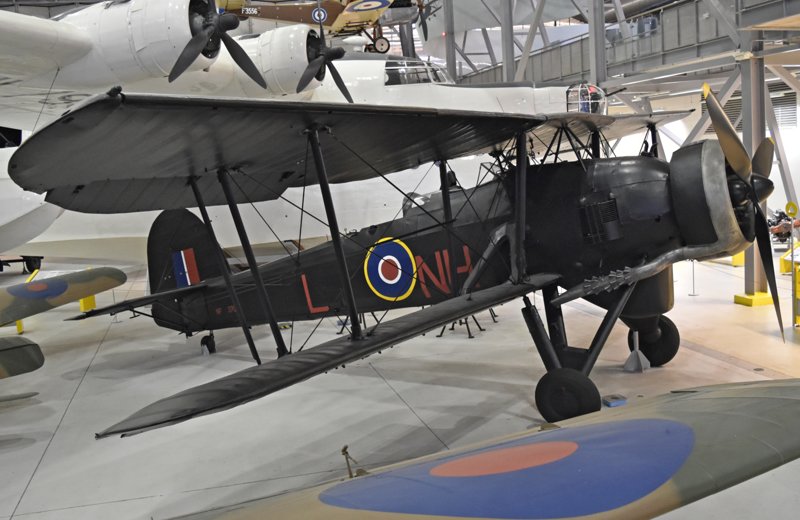
The "Mark III" added a Mark X "Air to Surface Vessel (ASV)" radar pod between the landing gear, as well as fittings for rocket-assisted takeoff gear (RATOG), allowing a heavily-laden Swordfish to get off the decks of the smallest carriers. The ASV radar pod meant the Mark III couldn't carry a torpedo or other large centerline store. The "Mark IV" was a Mark II retrofitted with an enclosed cockpit, for operations in Canada; apparently the "Mark IV" designation was informal, they were officially still Mark IIs.
BACK_TO_TOP* The Swordfish saw little action during 1939 and the first few months of 1940, operating mostly in convoy escort and for naval cover. Its first real action was in April 1940, when it served in the confused naval battles that accompanied the Nazi invasion of Norway. Norway was lost, though the German surface navy was badly mauled in the operation. On 11 April, Swordfish operating off the carrier HMS FURIOUS launched a torpedo attack on two destroyers at harbor in Trondheim. The attack was ineffectual, but it was the first airborne torpedo attack of the war.
Two days later, on 13 April, a Swordfish floatplane launched by catapult off the HMS WARSPITE flew up Ofot Fjord, which led to Narvik, and spotted seven German destroyers for the WARSPITE's guns. All the destroyers were sunk, or so badly damaged that they had to be scuttled. There were no casualties on the British side. The Swordfish in question also discovered a German submarine, the U-64, and sank it in a dive-bombing attack. It was the first U-boat sunk by an FAA aircraft in the war.
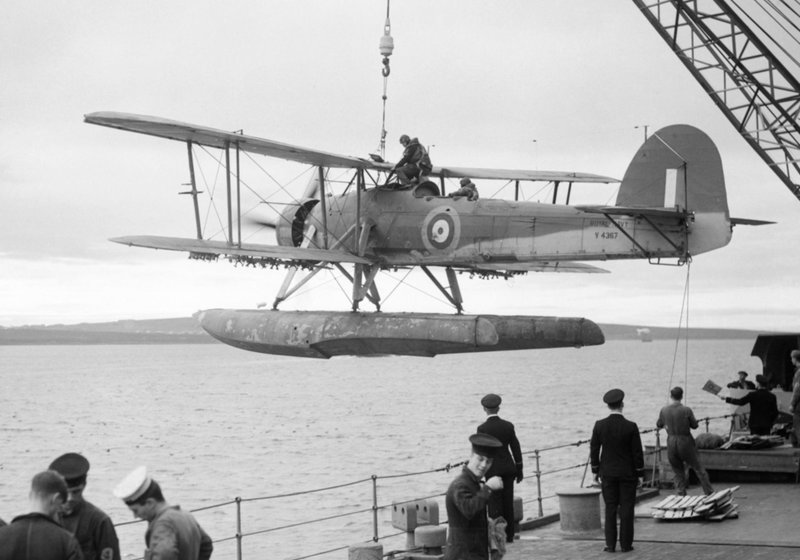
Over the next two weeks, Swordfish conducted constant sorties in Norwegian waters, performing strikes, reconnaissance, and antisubmarine patrols under severe weather conditions. Flying in bad weather was particularly unpleasant because the Swordfish didn't have an enclosed cockpit.
At the same time, Swordfish attached to the Royal Air Force (RAF) Coastal Command were operating out of the UK on mine-laying missions against German ports. The next month, the Nazi "Blitzkrieg" against the Low Countries and France forced the British to call on every resource they had to stave off disaster. Four squadrons of Swordfish in all were attached to Coastal Command and put to every task for which they were capable: mine-laying, bombing of naval and ground targets, spotting, and reconnaissance.
Swordfish operating out of the south of France took part in bombing raids against Italian targets in June, when Italy declared war against the French and British. A number of Swordfish left France and eventually ended up on the island of Malta, where they would successfully harass Axis shipping during the battle for North Africa.
When France fell, on 3 July 1940 the British took ruthless action to prevent French military assets from being used against them, striking at and demolishing the French fleet at dock in the harbor of Oran, in Algeria. Twelve Swordfish from the carrier HMS ARK ROYAL launched a torpedo attack on the battle cruiser DUNKERQUE, putting it out of action. On 8 July, Swordfish from the HMS HERMES hit the French battleship RICHELIEU at port in Dakar, Senegal, scoring a single torpedo hit on it.
The next month, on 22 August, three Swordfish operating from land attacked Italian warships sitting in the port of Bomba Bay, in Libya, destroying two submarines, a submarine tender, and a destroyer. The attackers sank four ships with only three torpedoes -- the destroyer was not hit directly, but went up when its tender exploded. The success of these attacks on ships in harbor led the British to consider a much more aggressive operation against the Italian Navy: a torpedo-bomber attack against the Italian Fleet at Taranto, the main naval base on the Italian mainland, in the "arch" of the boot-shaped Italian peninsula.
BACK_TO_TOP* An attack on Taranto had actually been considered in 1938, when war was becoming inevitable. In 1940, the strike plans were dusted off and updated. The main Italian fleet consisted of six battleships, consisting of two of the new LITTORIO class and four of the recently rebuilt CAVOUR and DUILIO class, plus five cruisers and twenty destroyers, all based at Taranto. Attacking the Italian fleet at anchor required high quality and up-to-date intelligence and reconnaissance, not merely to determine what ships were present but also to know their positions. The British strike force would also have to move silently to achieve surprise.
The plan, codenamed Operation JUDGEMENT, specified a night attack to reduce losses, and so Swordfish crews were put through a rigorous schedule of training for night flight and combat. The mission was scheduled for 21 October 1940, but was delayed to 11 November because of other naval commitments. A few days before the mission, the carrier EAGLE ran into trouble with her fuel systems. Several of her Swordfish were transferred to the carrier ILLUSTRIOUS, which then sailed from Alexandria, Egypt. While these forces were in transit, the Royal Navy was also conducting several convoy operations in the Mediterranean, most prominently a resupply convoy to the island of Malta; it was believed, correctly as it turned out, that so much activity at the same time would confuse the Italians about British intent.
Aerial reconnaissance performed by Martin Maryland bombers operating out of Malta on the morning of 11 November indicated that five Italian battleships were in Taranto harbor, with three cruisers at dock protected by antisubmarine nets. The sixth battleship was seen to enter the harbor later that day. By 8:00 PM that evening, the ILLUSTRIOUS and her escorts were in position, about 270 kilometers (170 miles) from the port. Twelve Swordfish were fitted up for the first wave of the attack: six carried torpedoes, four carried bombs, and two carried a combination of bombs and flares. The rear gunners were left behind, since the rear position was taken up by an additional fuel tank.
The first Swordfish took off at 8:35, and by 9:00 they were all in the air and on the way. Just before 11:00 PM, the two flare-droppers split off from the formation. One put a line of flares over the harbor from 2,300 meters (7,500 feet), and then bombed an oil storage depot. The strike aircraft attacked in two groups. The flight leader's plane was hit by flak and went down, but multiple hits were scored on several of the battleships.
In the meantime, a second wave had taken to the air about a half hour after the first. The second wave consisted of five aircraft armed with torpedoes, two armed with bombs, and two armed with flares and bombs. One had to turn back because of a technical problem, but the other eight arrived at about midnight and repeated the performance of the first wave, slamming torpedoes into the sitting battleships under the glare of the flares. Another Swordfish was lost to flak.
All the aircraft, except the two that had been shot down, were back on board the ILLUSTRIOUS before 3:00 AM that morning. Post-strike reconnaissance conducted two days later indicated that:
It was a brilliant action, inflicting massive damage on the Italian fleet with minimal losses to the British. The Italians withdrew their fleet to the north, effectively removing it from the Mediterranean game board. The Japanese had been thinking of more ambitious operations along similar lines as the Royal Navy; the following May, a delegation from a Japanese military mission to Germany and Italy visited Taranto to assess the raid.
* The Swordfish saw further action in the Mediterranean and the Mideast into the spring of 1941, but the aircraft's next shining role was in helping to sink the German battleship BISMARCK. On 23 May 1941, the BISMARCK was observed steaming south through the gap between Greenland and Iceland; British fleet elements steamed out to intercept her.
On 24 May, the new carrier VICTORIOUS launched nine Swordfish at 10:00 PM in the evening, but weather conditions were bad and the torpedo bombers only scored a single hit. The BISMARCK escaped, only to be spotted again by an RAF Coastal Command Consolidated Catalina flying boat on 26 May. Fifteen Swordfish were launched by the carrier ARK ROYAL that day, but attacked the British cruiser SHEFFIELD by mistake. Fortunately, another error balanced the first: the torpedoes of the aircraft had been armed with magnetic detonators, which were hopelessly unreliable, and the SHEFFIELD, maneuvering wildly in rough seas, escaped unscathed.
There was no time for recriminations and the fiasco proved valuable. Late in the day, fifteen Swordfish were launched in a storm, carrying torpedoes armed with much more reliable contact detonators. They scored two hits on the German battleship: one did no damage, but the other struck the vessel in her steering gear, forcing her to steam in circles. None of the aircraft were lost in the attack, though a German officer said: "It was incredible to see such obsolete-looking planes having the nerve to attack a fire-spitting mountain like the BISMARCK." The BISMARCK was sent to the bottom by Royal Navy gunfire the next day.
* One of the results of the sinking of the BISMARCK was that it convinced Hitler that his own surface fleet could not stand up to the Royal Navy and deployed them cautiously, under plenty of protection. When the German battleships SCHARNHORST, GNEISENAU, and PRINZ EUGEN left the French port of Brest on 12 February 1942, moving to Northern European ports where they would be less vulnerable to air attack, six Swordfish attacked and were all shot down by covering fighters. Of the 18 crewmen, only five survived. Lieutenant Commander Esmonde, who led the attack, was posthumously awarded the Victoria Cross.

The Swordfish suffered another setback on 5 April 1942, in the course of a Japanese Navy raid on Ceylon, now Sri Lanka, in the Indian Ocean. Six Swordfish flew out of Colombo to attack the Japanese strike force, with all shot down and only a few survivors. The Stringbag was never again used as a torpedo bomber. However, it had already been and would continue to be employed in another role against Hitler's main weapon in the Battle of the Atlantic: the U-boat.
BACK_TO_TOP* The Swordfish had been equipped with ASV radar as early as October 1940, to help it hunt down German U-boats cruising on the surface. Two months later, on 21 December 1941, a Swordfish operating from Gibraltar was the first aircraft to sink a submarine at night. A year and a half later, on 23 May 1943, a Swordfish was the first aircraft to prove the effectiveness of rockets in antisubmarine warfare when one Stringbag sunk the U-752 off the coast of Ireland, even though the U-boat put up a determined defense with its quadruple 20-millimeter flak guns.
May 1943 was the turning point in the Battle of the Atlantic. The Swordfish was one of the many weapons that inflicted enough losses on the German submarine force to finally give the Allies the upper hand in the battle for the sea lanes. The Swordfish was relatively easy to fly off tiny escort carriers, and so could provide cover for convoys from start to finish. The Swordfish proved particularly effective in escorting the Murmansk convoys to Russia through frigid Arctic waters.
In August 1944, Swordfish IIs operating from the escort carriers VINDEX and STRIKER as part of the Murmansk convoy JW.59 took on a wolf pack of nine U-boats attempting to attack the convoy. One U-boat was sunk, another damaged; the defense was so energetic that none of the ships in the convoy was sunk. When the carriers escorted a return convoy back from Russia, no U-boats attempted to attack it. The Swordfish would be credited with the sinking of 12 U-boats in all.
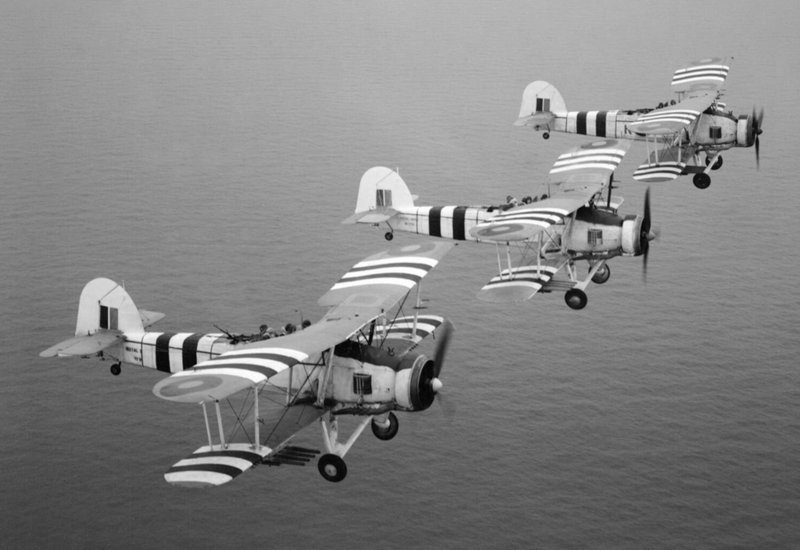
The final Swordfish was delivered in August 1944. Fairey had built 692 and Blackburn 1,699, for a total of 2,391. The last operational squadron was disbanded on 21 May 1945, shortly after the fall of Germany, and the last training squadron was disbanded in the summer of 1946. Despite its obsolescent appearance, the Stringbag had proven an excellent weapon, though its usefulness would have been far more limited if it had ever faced significant fighter opposition. The Swordfish today is represented by a handful of museum pieces and a few flying examples. Those finding a derelict Swordfish airframe today would indeed have a prize on their hands.
BACK_TO_TOP* Work on a successor to the Swordfish began in 1936 when the British Air Ministry issued Specification "S.41/36" for an improved torpedo bomber. Fairey's proposal was accepted "off the drawing board", with the Air Ministry ordering two prototypes and 98 production items of the "Albacore", as it was named, on 12 December 1938.
The first prototype performed its initial flight on 12 December 1938, with the type going into production in 1939. The overall configuration of the Albacore was very close to that of the Swordfish. The Albacore was a three-seat biplane, with fixed taildragger landing gear, and three crew consisting of pilot, navigator, and radio operator / rear gunner. It even resembled the Swordfish in adopting the same back-folding wing scheme.
It differed, however, in being larger, with an empty weight over half again as great as that of the Swordfish, being powered by a more powerful Bristol Taurus 14-cylinder two-row air-cooled radial engine driving a three-bladed variable-pitch propeller. Initial production was fitted with a Taurus II engine providing 795 kW (1,065 HP), while later production featured the Taurus XII with 845 kW (1,130 HP). Speed was incrementally better than that of the Swordfish, while ceiling and range were almost doubled.
It also featured such niceties as an enclosed cockpit with cockpit heating, a windshield wiper, and an emergency dinghy that was deployed automatically on ditching. Gun armament consisted of a single fixed 7.7-millimeter (0.303-caliber) machine gun mounted in the right wing, plus twin rearward-firing 7.7-millimeter Vickers K machine guns on a flexible mount in the rear cockpit. External stores consisted of a single 730-kilogram (1,610-pound) torpedo on the centerline; or six 115-kilogram (250-pound) bombs under the wings; or four 225-kilogram (500-pound) bombs under the wings.
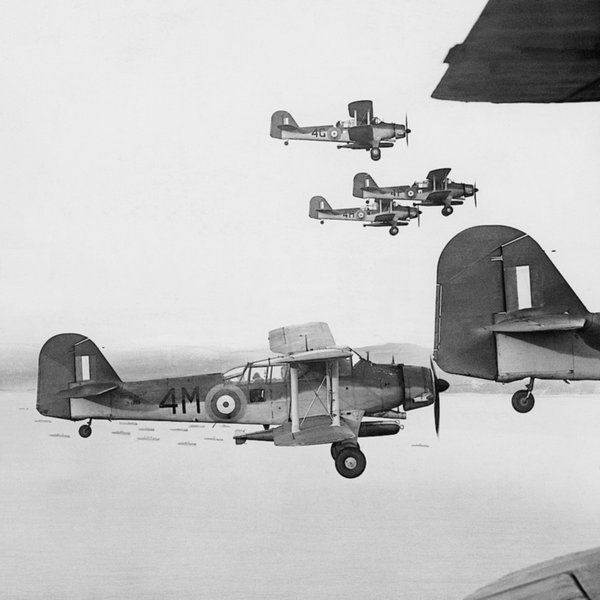
Although one of the prototype Albacores was tested with floats in 1940, the trials did not prove successful, and the Albacore never served operationally with floats.
___________________________________________________________________
FAIREY ALBACORE:
___________________________________________________________________
wingspan:
15.24 meters (50 feet)
wing area:
57.88 sq_meters (623 sq_feet)
length:
12.14 meters (39 feet 10 inches)
height:
4.32 meters (14 feet 2 inches)
empty weight:
3,289 kilograms (7,250 pounds)
MTO weight:
4,745 kilograms (10,460 pounds)
maximum speed:
259 KPH (161 MPH / 140 KT)
service ceiling:
6,310 meters (20,700 feet)
range, loaded:
1,497 kilometers (930 MI / 809 NMI)
___________________________________________________________________
Despite the fact that the Albacore was clearly more modern in appearance than the Swordfish, it didn't prove to be that much of an advance. The initial service evaluation of the type reported that its controls were very heavy, and that its stall behavior left something to be desired -- though it was stable in a dive, and steady in torpedo drops. The enclosed cockpit also didn't prove as much a benefit as might be expected, since the front cockpit was a "hotbox" in even mildly sunny weather, while the rear cockpit was drafty and chilly. It is still hard to believe that the enclosed cockpit wasn't superior to the open cockpit of the Swordfish, particularly for winter operations. In addition, some sources claim that in service pilots found it pleasant to fly, suggesting that the handling problems were worked out.
Albacores were rolled off the production line anyway, with a total of 800 built in all, including the two prototypes, all manufactured at the Fairey plant in Hayes. The type reached operational service in March 1940 and initially operated from ground bases. Albacores performed their first combat action on 31 May 1940, attacking German E-boats -- torpedo boats -- in the North Sea and hitting ground targets in Belgium. By the end of the year, the Albacore was flying off carriers, and performed its first torpedo-bombing attacks during the Battle of Cape Matapan, off the coast of Greece, on March 27:29 1941, in which the Royal Navy got the jump on the Italian fleet and badly bloodied it. Albacores off the HMS FORMIDABLE performed attacks on the Italian battleship VITTORIO VENETO during the battle.
The Albacore reached its peak strength in mid-1942, with the type equipping 15 FAA squadrons and service in all the war zones in which the Royal Navy was seriously involved. Albacores participated in Operation TORCH, the invasion of North Africa, in November 1942, flying ocean patrols and attacking coastal targets. Apparently some of them were given American markings for the operation. The type was generally phased out of service in 1943, to be replaced by the more modern Fairey Barracuda and, to a lesser extent, the Grumman Avenger.
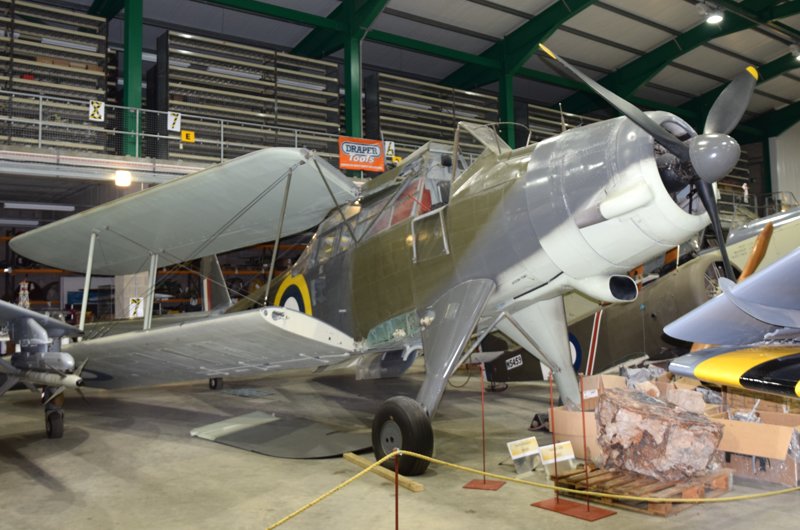
Although modern sources tend to be unkind to the Albacore, its short service life might have simply been due to the fact that a biplane combat aircraft was an idea whose time was generally past, even though the Swordfish was able to continue on in combat since it had found an effective niche in convoy escort. FAA Albacores remained in service in second-line squadrons in Africa and the Middle East for the rest of the war. Some Albacores were obtained by or passed on to the Royal Air Force and the Royal Canadian Air Force, and performed actions over the English Channel during the invasion of Normandy in the spring of 1944. At least one Albacore survives, at the FAA Museum at Ilchester in the UK.
BACK_TO_TOP* By the later 1930s, the concept of a biplane torpedo-bomber was becoming clearly stodgy, and in response to British Air Ministry Specification "S.24/37", Fairey submitted a design for a monoplane torpedo bomber. Fairey won the award in July 1938, receiving an order for two prototypes.
The first prototype of the "Barracuda", as the type was named, performed its initial flight on 7 December 1940, with the second flying on 29 June 1941. Although performance was much superior to the Swordfish and Albacore, the program moved along slowly, partly due to repeated changes in production priorities as forced by the pressures of war. Initial deliveries of the production "Barracuda Mark I" weren't until early 1942, and it didn't go into operational service until much later in the year. It was still the FAA's first operational monoplane torpedo-bomber.

The Barracuda Mark I was a high-wing monoplane with taildragger landing gear, the main gear retracting outward into the wing and the tail gear being fixed. It was of all-metal construction, except for some fabric-covered control surfaces. There was a yoke-style arresting hook in front of the tailwheel. The three crew -- again consisting of pilot, navigator, and radio operator / rear gunner -- sat in a "greenhouse" style canopy. There were two windows on each side of the fuselage, one directly under the middle of the wing and one at the trailing edge of the wing. Auxiliary lower seating was provided to allow use of the windows for observation.
The wing featured large underslung "Fairey-Youngman" flaps, the flaps also serving as dive brakes. The wings folded; it is unclear what the folding arrangement was, though there were pull-out handles under the outer wing to help the deck crew perform the folding. The tail configuration of the initial prototype had been conventional, but interference from the flaps under certain conditions led to moving the tailplane to near the top of the tailfin. The tailplane featured strut bracing, added when the tailplane position was raised.
Although the aircraft had been originally designed to use a Rolls-Royce 24-cylinder water-cooled inline "X" or "Vulture" engine with 895 kW (1,200 HP), that engine development program proved troublesome and was abandoned, and the Barracuda Mark I was powered by a Rolls-Royce Merlin 30 12-cylinder water-cooled inline with 970 kW (1,300 HP) and driving a Rotol (Rolls-Bristol) three-blade variable-pitch propeller. The engine change was another reason for delays in the program. Unfortunately, the Mark I had suffered from excessive weight gain from the original design and was underpowered. Only 30 Mark Is were built before production switched to the "Barracuda Mark II", which was generally identical to the Mark I except for fit of a substantially more powerful Merlin 32 engine, with 1,225 kW (1,640 HP), driving a four-bladed Rotol variable pitch propeller. The Mark II would become the main production model.
Defensive armament of the Barracuda consisted of two 7.7-millimeter (0.303-caliber) machine guns on a twin flexible mount in the rear of the cockpit. Offensive stores could be carried on the centerline and under a pylon under each outer wing. Possible offensive warloads included a single 735-kilogram (1,620-pound) torpedo carried on the centerline, or an equivalent load of bombs, depth charges, mines, flares and smoke markers, and sonar buoys ("sonobuoys").

Detail illustrations of the Mark II also display stores such as a target-towing winch, as well as gear for the air-sea rescue (ASR) role, with underwing inflatable life raft dispensers. It is unclear if if the Barracuda was ever formally used as a target tug or for the ASR role, though a picture does survive of a Mark II carrying a lifeboat on the centerline in a strictly experimental fit.
___________________________________________________________________
FAIREY BARRACUDA:
___________________________________________________________________
performance figures are given "clean", without external stores
wingspan:
14.99 meters (49 feet 2 inches)
wing area:
38.46 sq_meters (414 sq_feet)
length:
12.12 meters (39 feet 9 inches)
height:
3.73 meters (12 feet 3 inches)
empty weight:
4,907 kilograms (10,818 pounds)
MTO weight:
6,464 kilograms (14,250 pounds)
maximum speed:
386 KPH (240 MPH / 210 KT)
service ceiling:
5,060 meters (16,600 feet)
range:
1,850 kilometers (1,150 MI / 1,000 NMI)
___________________________________________________________________
Co-production of the Barracuda was arranged at Blackburn, Boulton Paul, and Westland, but Westland only built a small handful before the company was redirected to other aircraft production. A total of 1,688 Barracuda Mark IIs was built by the production pool.
* The Barracuda went into formal FAA service with Number 827 Squadron on 10 January 1943. By January 1944, there was a total of 12 Barracuda squadrons. The type performed a particularly significant action on 3 April 1944, with 42 dive-bombing the German battleship TIRPITZ and inflicting serious damage. They came back over the next few months to inflict more. By that spring, Barracudas were also in service in the Pacific, performing their first attack on Japanese targets at Sabang in Sumatra on 19 April 1944.
* The "Barracuda Mark III" was essentially a Mark II fitted with centimetric ASV.X radar in a blister radome under the rear fuselage. Some pictures of Mark IIs seem to suggest that at least a few were fitted with the earlier and less effective longwave ASV.II radar, with a Yagi-style "fishbone" receiving antenna above each wing, though the antennas might have actually been part of some sort of radar-homing gear. The first Mark III prototype, rebuilt from a Mark II, performed its initial flight in 1943, with production of the Mark III beginning in early 1944. The Mark II remained in production in parallel. A total of 852 Marks IIIs was built by Fairey and Boulton Paul. It was used on escort carriers for antisubmarine duty, performing takeoffs with RATOG.
Plans for a Mark IV fell through, and so the last production variant was the "Barracuda Mark V". Even with the improved Merlin 32, the Mark II/III was still seen as underpowered, and so Fairey engineers looked to the new Rolls-Royce Griffon vee-12 water-cooled engine. However, development of a Griffon-powered Barracuda stretched out, with the first prototype, a modified Mark II, performing its initial flight on 16 November 1944, when the war in Europe was clearly approaching its final stages.
The Barracuda Mark V featured a Griffon 37 engine providing 1,515 kW (2,030 HP) and increased fuel capacity, as well as a wing with increased span and squared-off wingtips to handle the greater weight, plus a larger tailfin to compensate for the increased torque of the Griffon engine. Crew was reduced to two and the rearward-firing Vickers guns were deleted, with a single fixed forward-firing 12.7-millimeter (0.50-caliber) Browning machine gun in their place.
Only 30 Mark Vs were completed before the end of the war in the Pacific led to the end of Barracuda production. The Mark Vs served in training roles until 1950. Most of the Mark II/III squadrons were disbanded after the end of the war, but some Mark II/IIIs remained in service as hacks and the like into the early 1950s.
The Barracuda seems remains obscure compared to its far more famous contemporary, the Grumman Avenger; tales linger of the Barracuda's bad reputation, it seems mostly due to the fact that it was underpowered and too slow. Apparently no Barracudas have survived, though an interest group has been collecting pieces of wrecks in hopes of putting together a static display item.
* Late in the war, Fairey also developed a bigger and more formidable torpedo and dive bomber, the "Spearfish". It was designed in response to specification "O.5/43" as a replacement for the Barracuda, and the first prototype performed its initial flight on 5 July 1945.
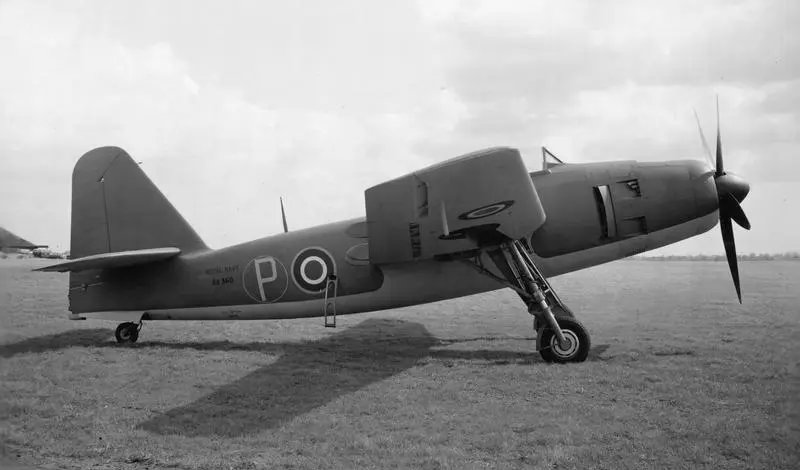
The Spearfish was a mid-wing monoplane, with two crew in a greenhouse canopy, powered by a Bristol Centaurus 57 two-row 18-cylinder radial engine, providing 1,930 kW (2,585 HP) and driving a Rotol variable-pitch five-bladed propeller. It was a taildragger machine, with all landing gear retractable, the main gear retracting outward into the wings. The wings featured hydraulic folding. It had two fixed forward-firing 12.7-millimeter (0.50-caliber) Browning machine guns, and two more 12.7-millimeter Brownings in a remote-controlled barbette for rearward defense. It had an internal bomb bay but could also carry 16 rocket projectiles under the wings, total offensive warload being of 900 kilograms (2,000 pounds). It was fitted with ASV radar in a retractable "dustbin" under the rear fuselage, and had provision for RATOG.
___________________________________________________________________
FAIREY SPEARFISH:
___________________________________________________________________
wingspan:
18.3 meters (60 feet)
wing area:
49.2 sq_meters (530 sq_feet)
length:
13.8 meters (45 feet 4 inches)
height:
5 meters (16 feet 6 inches)
loaded weight:
10,000 kilograms (22,050 pounds)
maximum speed:
482 KPH (298 MPH / 259 KT)
range:
1,440 kilometers (900 MI / 783 NMI)
___________________________________________________________________
Five Spearfish prototypes were built, but only four flew, with the program terminated by the end of the war in the Pacific. The prototypes were used for trials for a time after the war.
BACK_TO_TOP* The story of the blundering Swordfish attack on the HMS SHEFFIELD and the failure of the magnetic detonators is part of another interesting story. Magnetic detonators were designed to cause a torpedo to explode while it was passing underneath the hull of a ship, without actually striking it. The idea was that this would inflict greater and more devastating damage than a torpedo hitting the side of the ship.
The idea sounded nice in principle but failed miserably in practice, and most European nations quickly got rid of the magnetic detonators. In the early days of the war in the South Pacific, however, American submarine commanders were specifically ordered to use magnetic detonators. They protested at length that the detonators didn't work, but the brass stubbornly insisted. Submarine commanders resorted to leaving port with magnetic detonators fitted to their torpedoes -- only to replace them with contact detonators once they got to sea and no longer had to put up with inspections.
* Sources include:
* Illustrations credits:
* Revision history:
v1.0 / 16 aug 97 / Originally on Swordfish only. v1.1 / 01 feb 98 / Review & polish. v1.0.2 / 01 jan 02 / Review & polish. v2.0.0 / 01 jan 04 / Added Albacore & Barracuda. v2.0.1 / 01 jan 06 / Review & polish. v2.0.2 / 01 dec 07 / Review & polish. v2.0.3 / 01 nov 09 / Review & polish. v2.1.0 / 01 oct 11 / Additional Swordfish details. v2.1.1 / 01 sep 13 / Review & polish. v2.1.2 / 01 aug 15 / Review & polish. v2.1.3 / 01 jul 17 / Review & polish. v2.1.4 / 01 jun 19 / Review & polish. v2.1.5 / 01 apr 21 / Review & polish. v2.2.0 / 01 apr 23 / Review & polish. v2.2.1 / 01 apr 25 / Review & polish. (+)BACK_TO_TOP
